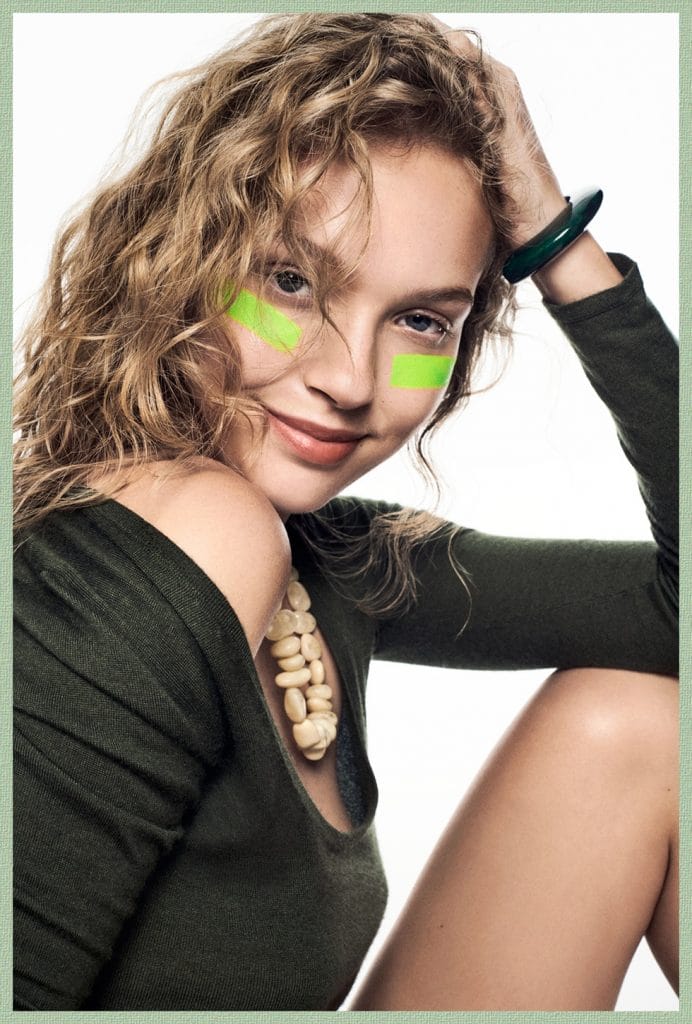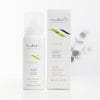
Gabriela Hearst Emily Scoop Neck Body Suit, $650, modaoperandi.com; Dinosaur Design Necklace; Lizzie Fortunato Arc Cuff, $195, nordstrom.com; Bare Republic Neon Sunscreen Stick in Goblin Green, $7.99, ulta.com.
DANIEL THOMAS SMITH
There are two types of sunscreens: mineral and chemical. The former uses zinc or titanium dioxide to physically scatter and deflect the DNA-damaging UV rays that can lead to premature skin aging and cancer. Mineral sunscreens tend to be gentler and more natural, therefore, safer for babies and those with sensitive skin.
Chemical sunscreens use ingredients like avobenzone, homosalate, octisalate, octocrylene, or oxybenzone to create a chemical reaction on your skin, turning the harmful UV rays into heat. These chemical sunscreens are often easier and more luxurious to apply, since they’re lightweight, readily absorbed, and leave behind no white cast. Both work if you use the right amount and remember to reapply. Both can save your life.

Why chemical sunscreens are bad for your health
Oxybenzone, also known as benzophenone-3 (BP3), is the most notorious chemical UV filter used in an estimated 60 percent of U.S. sunscreen formulas. This helps explain why traces of the chemical have been found in 97 percent of the U.S. population’s urine. Five years ago, the data linking oxybenzone to testosterone fluctuations in men and postmenopausual women was considered clinically insignificant. The authors of every recent study now agree that the ingredient is strongly suspected of being an estrogenic hormone disruptor and that it passes through the placental barrier, leading to low birth weight and birth defects like Hirschsprung’s disease. A study from 2016 found a link between exposure to chemical UV filters and male infertility. In May 2019, the FDA confirmed that the “systemic absorption” of oxybenzone and other chemical filters from sunscreen exceeds the recommended threshold, which is particularly problematic for children. What’s more, oxybenzone and other chemical filters have been shown to be allergenic and irritating for people with skin conditions like rosacea, since they cause a heat-based chemical reaction on the skin’s surface. The FDA recently proposed sweeping changes to sunscreen regulations, including the ban of two once-common ingredients: para-aminobenzoic acid (PABA) and trolamine salicylate. The agency is currently reviewing safety data of 12 chemical sunscreen ingredients, with results expected later this year.
TIP: Mineral sunscreens are without a doubt your safest bet—unless you somehow inhale them. Zinc and titanium dioxide can be toxic to lung tissue, which is only likely to happen when particles are inhaled through something like a spray sunscreen. There aren’t many mineral spray sunscreens on the market for this very reason—but there are a few. Stick to creams, mousses, or pastes instead.
Why chemical sunscreens are bad for the environment
Sunscreen doesn’t just evaporate into thin air. When you swim in the ocean or take a shower, chemical sunscreen filters make their way into our waterways and water supply. “Studies have identified UV filters such as oxybenzone, octocrylene, octinoxate, and ethylhexyl salicylate in almost all water sources around the world and have commented that these filters are not easily removed by common wastewater treatment plant techniques,” concluded the authors of a January 2019 study published inJAMA. “Additionally, in laboratory settings, oxybenzone has been implicated specifically as a possible contributor to coral reef bleaching.” It’s because of the risk to ocean coral that Hawaii, Key West, and the U.S. Virgin Islands have all passed laws banning the sale of sunscreens containing oxybenzone and octinoxate. More states and cities are expected to follow suit.
If it’s in the ocean, it’s also in our seafood. The ingredients 4-methylbenzylidene camphor, oxybenzone, octocrylene, and octinoxate have been found in small levels in sea organisms around the world, raising concerns about bioaccumulation in humans, as well as toxicity to the fish itself. “Oxybenzone can also react with chlorine, producing hazardous by-products that can concentrate in swimming pools and wastewater treatment plants,” according to a 2018 study published in the Journal of Cosmetic Dermatology.

What to look for in a daily sunscreen
If you’re committed to adopting a cleaner beauty routine, reach for a mineral sunscreen containing zinc or titanium dioxide with an SPF value of at least 30. Smear it on vigilantly leaving no skin uncovered (creams are better than sprays), then reapply every two to three hours, or after splashing in the water. Opt for formulas that are free of insect repellents or derivatives of vitamin A (retinyl palmitate, retinol, retinyl acetate, retinyl linoleate, and retinoic acid), which can cause increased skin photosensitivity and oxidative damage.
The hard truth: The more natural the sunscreen formula, the higher the chance its application will be ultra-thick, sticky, and opaque. It’s the price you pay for a safer and greener option until something better comes along, as there’s no such thing as a natural chemical sunscreen. Your only other choice is to stay out of the sun. Seek shade, wear a big-ass hat, or cover up when outdoors with UPF clothing.
From: Harper’s BAZAAR US



